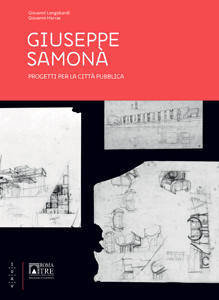
To retrace the paths of Giuseppe Samonà.
A book following two exhibitions and a conference
It is understandable the difficulty in framing the publication “GIUSEPPE SAMONA ‘projects for the public city” in a specific non-fiction genre, edited by Giovanni Longobardi Giovanni Marras, when the subject concerns the Master who gave life to the IUAV tradition through an extraordinary multiple cultural, theoretical, didactic, design expressions, all pervaded by a repeated desire for knowledge. In the combination of two exhibitions and a conference held in 2018, in which the Department of Architecture of Roma Tre and the IUAV with the Projects Archive concur, the book seems to play a further stimulating function especially for students and younger scholars on he actuality of that hermeneutics which for Samonà involves all the scales and components of the architectural, urban and territorial scene almost an impossibility, now as then, of being able to carry out the work of the architect in the key of a positivistic specialism. Within a framework, that “for the public city”, as the subtitle states, which highlights the ethical and political purpose of the experience of this intellectual, happily transplanted from the southern Mediterranean to the lagoon dimension of the “dominant”, the series of short chapters of the volume indicate the paths from 1949 to 1983 through which his activity produced and above all gave rise to further school research. In that IUAV intended above all as a great laboratory of comparison and cultural elaboration of a high educational level. Hence the questions of how to conceive a post-academic school of architecture, in an Italian key without Bauhausian replicas, on the basis of an interpretative practice adhering to reality and of a transcalar nature in the application of an experimental design exercise as Giovanni explains. Marras, one of the most qualified exegete of the Samonan cosmos; the typological aspect is also central, underlined by Giovanni Longobardi, where the design experiments on the epochal theme of the “business center” emerge through various projects, including the one for Turin (1962) which plays so much part of the reflection on modernity investigated by Francesco Tentori through his “Learning from Venice” 1; no less important is the figurative response of the projects also carried out, according to an iconic tension capable of bringing urban materials on the same semantic level, between projects in the Veneto area (Pujia) and in the land of Sicily (Lombards). Serena Maffioletti recalls the Samonà “captain of fortune”, according to the vivid definition of Carlo Aymonino, bringing out that combinatorial alchemy of a recruitment as heteronomous as culturally excellent between personalities with marked but differentiated qualities such as Trincanato, Scarpa, Astengo, Zevi, Piccinato, Gardella up to Saverio Muratori in counterpoint to that very young De Carlo, the bearer of renewed modernist instances, whose nemesis will be seen in the project for Mazzorbo. The book in the second part reports the usual acute introspection of Franco Purini with an accent, almost a suggestion of research, to the relations of the Sicilian master with Giovannoni, Piacentini and the philosopher Adolfo Omodeo. No less significant is the contribution of Vieri Quilici, of historical contextualization of the work of Samonà among the new themes of a settlement that becomes territorial but at the same time of a renewed attention, first of all on the models of an operational interpretation, for the historic city. The testimony of the Samonan followers is Luciano Semerani who together with Polesello, Dardi and others has conferred on the continuity of character of that school until the end of the twentieth century and even today. I was a young PhD student at the IUAV in 1984 2, so a few months after Samonà’s death, we were not yet carried away by the equivocal rhetoric of sustainability, vertical greenery, bigness, and in that climate I still remember today in the words, in the ways, but especially in the topics that the college of teachers submitted to us what I like to define the spirit of Samonà, its authenticity of problematic arousal used as a maieutic key. What this little book, enriched by an extraordinary supply of images and drawings, even unpublished, continues to reiterate its inexhaustible relevance.
Carlo Quintelli
Notes1 F. Tentori, Imparare da Venezia, Officina, Rome 1994.
2The first cycle of the PhD in Architectural Composition at the IUAV (1983-1986), in consortium with the Milan Polytechnic and the University of Naples, had a Board of Professors composed of E. Battisti, G. Canella, A. Drugman, G. Grassi, G. Polesello, A. Rossi, A. Samonà, L. Semerani, U. Siola and with F. Tentori as coordinator and M. Montuori as secretary.
Edited by: Giovanni Longobardi, Giovanni Marras
Title: Giuseppe Samonà
Subtitle: Progetti per la città pubblica
Language: italian and english abstract
Publisher: Dipartimento di Architettura di Roma Tre / Archivio Progetti IUAV / Universalia Pordenone
Characteristics: cm 23x17, pages 156, paperback, color
ISBN: 978-88-941359-8-5
Year: 2020